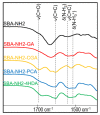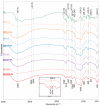Antioxidant-Loaded Mesoporous Silica-An Evaluation of the Physicochemical Properties
- PMID: 35883907
- PMCID: PMC9312088
- DOI: 10.3390/antiox11071417
Antioxidant-Loaded Mesoporous Silica-An Evaluation of the Physicochemical Properties
Abstract
The dangerous effects of oxidative stress can be alleviated by antioxidants—substances with the ability to prevent damage caused by reactive oxygen species. The adsorption of antioxidants onto nanocarriers is a well-known method that might protect them against rough environ-mental conditions. The aim of this study was to investigate the adsorption and desorption of gallic acid (GA), protocatechuic acid (PCA), chlorogenic acid (CGA), and 4-hydroxybenzoic acid (4-HBA) using commercially available mesoporous silica materials (MSMs), both parent (i.e., SBA-15 and MCM-41) and surface functionalized (i.e., SBA-NH2 and SBA-SH). The MSMs loaded with active compounds were characterized using Fourier transform infrared spectroscopy (FTIR), scanning electron microscopy with energy-dispersive X-ray spectroscopy (SEM-EDX), thermogravimetric analysis (TGA), differential scanning calorimetry (DSC), thermoporometry (TPM), and powder X-ray diffraction (XRD). High-performance liquid chromatography (HPLC-CAD) was used to evaluate the performance of the adsorption and desorption processes. The antioxidant potential was investigated using the Folin−Ciocalteu (FC) spectrophotometric method. Among the studied MSMs, the highest adsorption of GA was observed for amine-modified SBA-15 mesoporous silica. The adsorption capacity of SBA-NH2 increased in the order of PCA, 4-HBA < GA < CGA. Different desorption effectiveness levels of the adsorbed compounds were observed with the antioxidant capacity preserved for all investigated compounds.
Keywords: adsorption; antioxidant potential; antioxidants; desorption; mesoporous silica.
Conflict of interest statement
The authors declare no conflict of interest.
Figures







Similar articles
-
Exploring the Transformative Potential of Functionalized Mesoporous Silica in Enhancing Antioxidant Activity: A Comprehensive Review.Antioxidants (Basel). 2024 Aug 1;13(8):936. doi: 10.3390/antiox13080936. Antioxidants (Basel). 2024. PMID: 39199182 Free PMC article. Review.
-
Adsorption and release of ampicillin antibiotic from ordered mesoporous silica.J Colloid Interface Sci. 2017 Jul 1;497:217-225. doi: 10.1016/j.jcis.2017.03.021. Epub 2017 Mar 6. J Colloid Interface Sci. 2017. PMID: 28285049
-
Zinc Removal from Water via EDTA-Modified Mesoporous SBA-16 and SBA-15.Toxics. 2023 Feb 23;11(3):205. doi: 10.3390/toxics11030205. Toxics. 2023. PMID: 36976971 Free PMC article.
-
Modified SBA-15 mesoporous silica for heavy metal ions remediation.Chemosphere. 2008 Nov;73(9):1499-504. doi: 10.1016/j.chemosphere.2008.07.039. Epub 2008 Aug 28. Chemosphere. 2008. PMID: 18760443
-
Adsorption of lysozyme on hyaluronic acid functionalized SBA-15 mesoporous silica: a possible bioadhesive depot system.Langmuir. 2014 Nov 4;30(43):12996-3004. doi: 10.1021/la503224n. Epub 2014 Oct 21. Langmuir. 2014. PMID: 25295387
Cited by
-
Exploring the Transformative Potential of Functionalized Mesoporous Silica in Enhancing Antioxidant Activity: A Comprehensive Review.Antioxidants (Basel). 2024 Aug 1;13(8):936. doi: 10.3390/antiox13080936. Antioxidants (Basel). 2024. PMID: 39199182 Free PMC article. Review.
-
Porous Silica Nanomaterials as Carriers of Biologically Active Natural Polyphenols: Effect of Structure and Surface Modification.Pharmaceutics. 2024 Jul 29;16(8):1004. doi: 10.3390/pharmaceutics16081004. Pharmaceutics. 2024. PMID: 39204349 Free PMC article. Review.
-
Increasing Bioavailability of Trans-Ferulic Acid by Encapsulation in Functionalized Mesoporous Silica.Pharmaceutics. 2023 Feb 16;15(2):660. doi: 10.3390/pharmaceutics15020660. Pharmaceutics. 2023. PMID: 36839982 Free PMC article.
-
Recent Advancements in Gallic Acid-Based Drug Delivery: Applications, Clinical Trials, and Future Directions.Pharmaceutics. 2024 Sep 13;16(9):1202. doi: 10.3390/pharmaceutics16091202. Pharmaceutics. 2024. PMID: 39339238 Free PMC article. Review.
References
Grants and funding
LinkOut - more resources
Full Text Sources
Research Materials
Miscellaneous

